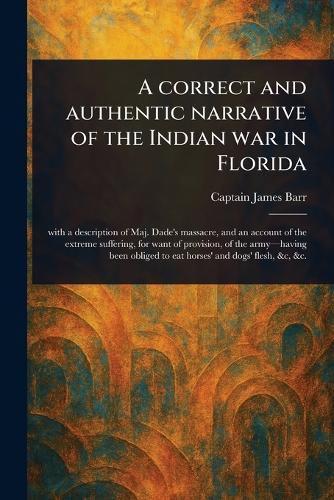Readings Newsletter
Become a Readings Member to make your shopping experience even easier.
Sign in or sign up for free!
You’re not far away from qualifying for FREE standard shipping within Australia
You’ve qualified for FREE standard shipping within Australia
The cart is loading…






This title is printed to order. This book may have been self-published. If so, we cannot guarantee the quality of the content. In the main most books will have gone through the editing process however some may not. We therefore suggest that you be aware of this before ordering this book. If in doubt check either the author or publisher’s details as we are unable to accept any returns unless they are faulty. Please contact us if you have any questions.
"A correct and authentic narrative of the Indian war in Florida," by Capt. James Barr, offers a firsthand account of the Second Seminole War (1835-1842). This historical narrative provides a vital perspective on the conflict between the United States and the Seminole people in Florida.
Barr meticulously recounts key events, including a detailed description of Maj. Dade's massacre, a pivotal and devastating moment in the war. The narrative further explores the extreme hardships endured by the U.S. Army, vividly depicting their struggle for survival and the desperate measures they were forced to take due to lack of supplies.
A valuable resource for those interested in military history, Native American history, and the history of Florida, this book sheds light on a complex and often overlooked chapter in American history. It offers insights into the challenges and brutal realities of 19th-century warfare and the clash of cultures in the American South.
This work has been selected by scholars as being culturally important, and is part of the knowledge base of civilization as we know it.
This work is in the public domain in the United States of America, and possibly other nations. Within the United States, you may freely copy and distribute this work, as no entity (individual or corporate) has a copyright on the body of the work.
Scholars believe, and we concur, that this work is important enough to be preserved, reproduced, and made generally available to the public. We appreciate your support of the preservation process, and thank you for being an important part of keeping this knowledge alive and relevant.
$9.00 standard shipping within Australia
FREE standard shipping within Australia for orders over $100.00
Express & International shipping calculated at checkout
This title is printed to order. This book may have been self-published. If so, we cannot guarantee the quality of the content. In the main most books will have gone through the editing process however some may not. We therefore suggest that you be aware of this before ordering this book. If in doubt check either the author or publisher’s details as we are unable to accept any returns unless they are faulty. Please contact us if you have any questions.
"A correct and authentic narrative of the Indian war in Florida," by Capt. James Barr, offers a firsthand account of the Second Seminole War (1835-1842). This historical narrative provides a vital perspective on the conflict between the United States and the Seminole people in Florida.
Barr meticulously recounts key events, including a detailed description of Maj. Dade's massacre, a pivotal and devastating moment in the war. The narrative further explores the extreme hardships endured by the U.S. Army, vividly depicting their struggle for survival and the desperate measures they were forced to take due to lack of supplies.
A valuable resource for those interested in military history, Native American history, and the history of Florida, this book sheds light on a complex and often overlooked chapter in American history. It offers insights into the challenges and brutal realities of 19th-century warfare and the clash of cultures in the American South.
This work has been selected by scholars as being culturally important, and is part of the knowledge base of civilization as we know it.
This work is in the public domain in the United States of America, and possibly other nations. Within the United States, you may freely copy and distribute this work, as no entity (individual or corporate) has a copyright on the body of the work.
Scholars believe, and we concur, that this work is important enough to be preserved, reproduced, and made generally available to the public. We appreciate your support of the preservation process, and thank you for being an important part of keeping this knowledge alive and relevant.